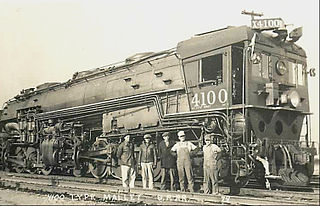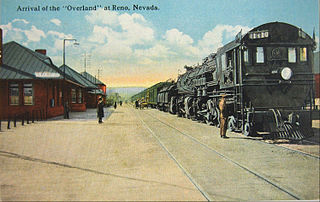
A steam locomotive is a locomotive that provides the force to move itself and other vehicles by means of the expansion of steam. It is fuelled by burning combustible material to heat water in the locomotive's boiler to the point where it becomes gaseous and its volume increases 1,700 times. Functionally, it is a steam engine on wheels.

A Mallet locomotive is a type of compound articulated steam locomotive, invented by the Swiss engineer Anatole Mallet (1837–1919).

The Southern Pacific was an American Class I railroad network that existed from 1865 to 1996 and operated largely in the Western United States. The system was operated by various companies under the names Southern Pacific Railroad, Southern Pacific Company and Southern Pacific Transportation Company.

A 2-8-8-4 steam locomotive, under the Whyte notation, has two leading wheels, two sets of eight driving wheels, and a four-wheel trailing truck. The type was generally named the Yellowstone, a name given it by the first owner, the Northern Pacific Railway, whose lines ran near Yellowstone National Park. Seventy-two Yellowstone-type locomotives were built for four U.S. railroads.

Under the Whyte notation for the classification of steam locomotives, 4-8-4 represents the wheel arrangement of four leading wheels on two axles, eight powered and coupled driving wheels on four axles and four trailing wheels on two axles. The type was first used by the Northern Pacific Railway, and initially named the Northern Pacific, but railfans and railroad employees have shortened the name since its introduction. It is most-commonly known as a Northern.

The California State Railroad Museum is a museum in the California State Parks system that interprets the role of railroads in the Western U.S.. It is located in Old Sacramento State Historic Park at 111 I Street, Sacramento, California.

Main components found on a typical steam locomotive include:

A camelback locomotive is a type of steam locomotive with the driving cab placed in the middle, astride the boiler. Camelbacks were fitted with wide fireboxes which would have severely restricted driver visibility from the normal cab location at the rear.

The Pennsylvania Railroad's S2 class was a steam turbine locomotive designed and built in a collaborative effort by Baldwin Locomotive Works and Westinghouse Electric & Manufacturing Company, as an attempt to prolong the dominance of the steam locomotive by adapting technology that had been widely accepted in the marine industry. One was built, #6200, delivered in September 1944. The S2 was the sole example of the 6-8-6 wheel arrangement in the Whyte notation, with a six-wheel leading truck keeping the locomotive stable at speed, eight powered and coupled driving wheels, and a six-wheel trailing truck supporting the large firebox. The S2 used a direct-drive steam turbine provided by the Westinghouse Electric & Manufacturing Company, geared to the center pair of axles with the outer two axles connected by side rods; the fixed gear ratio was 18.5:1. Such design was to prevent energy loss and S2 achieved a mechanical efficiency of 97% which means only 3% of steam energy was lost within the propulsion equipment. The disadvantage of a direct-drive steam turbine was that the turbine could not operate at optimal speeds over the locomotive's entire speed range. The S2 was the largest, heaviest and fastest direct-drive turbine locomotive design ever built.

Under the Whyte notation for the classification of steam locomotives, a 4-8-8-2 is a locomotive with four leading wheels, two sets of eight driving wheels, and a two-wheel trailing truck.

The term cab forward locomotive refers to various rail and road vehicle designs that place the driver's compartment substantially farther towards the front than is common practice.

Southern Pacific Railroad's AC-4 class of steam locomotives was the first class of 4-8-8-2 cab forward locomotives. They were intended to improve on the railroad's MC (Mallet-Consolidation) class 2-8-8-2 locomotives with a larger firebox, hence, the four-wheel leading truck.
Southern Pacific Railroad's AC-7 class of cab forward steam locomotives was the fourth class of the 4-8-8-2 locomotives purchased by Southern Pacific (SP). The locomotives were built by Baldwin Locomotive Works and shared many of the same characteristics of previous AC class locomotives.

Southern Pacific Railroad's AC-12 class of simple articulated 4-8-8-2 cab forward steam locomotives was the last class of steam locomotives ordered by Southern Pacific. They were built by Baldwin Locomotive Works during World War II, with the first, number 4275, entering service on October 27, 1943, and the last, 4294, on March 19, 1944. The locomotives were effectively a conventional 2-8-8-4 locomotive running in reverse; the tender being coupled at the smokebox end of the locomotive. This was made possible by the use of oil-firing. The distinct features of these locomotives include: a streamlined front with white band, an air horn on the front, a streamlined pilot, a SP 12 wheel box tender, and air compressors mounted on the smokebox. Southern Pacific used these locomotives all over its system, but they were extremely famous for working on Donner Pass & Cascade Summit.

Southern Pacific Company's MM-2 class of steam locomotives was one of Southern Pacific's (SP) only classes of 2-6-6-2 locomotives ordered and built as oil-fired cab forward locomotives. They were built in 1911 as compound-expansion Mallet locomotives by Baldwin Locomotive Works and entered service on SP beginning September 19, 1911. By 1914, they had all been upgraded with an additional leading axle making them 4-6-6-2 locomotives, reclassified from MM-2 to AM-2. This was done to improve handling at speed. These locomotives were the predecessors of several other cab-forward engines, culminating in the AC-12 class cab forward locomotives built during World War II.

Southern Pacific Railroad's MC-2 class of steam locomotives was the first class to be ordered by and built for Southern Pacific (SP) as cab forward locomotives. They were built in 1909 following the design of SP's MC-1 class built earlier that year. The success of this locomotive model led to the design and introduction of the AC class of 4-8-8-2 cab forward locomotives in the 1930s and 1940s.

Southern Pacific Railroad's AC-1 class of cab forward steam locomotives consisted of locomotives rebuilt from MC-1 and MC-2 class locomotives that were originally built by Baldwin Locomotive Works in 1909. The MC-2 class was the first class of locomotives built and delivered to SP as cab forward locomotives in late 1909. The AC-1 class was the first of the successful AC series of cab forward locomotives that numbered nearly 200 in total on the SP. Southern Pacific No. 4002 was rebuilt in June 1923 as a Cab Forward.

Southern Pacific 9010 is a KM ML 4000 C'C' diesel-hydraulic locomotive, built in 1964 by German manufacturer Krauss-Maffei for the Southern Pacific Railroad. SP 9010 generated 4,000 horsepower (3,000 kW) from two 2,000-horsepower (1,500 kW) V16 Maybach MD870 diesel engines. It was painted to Southern Pacific's 1958 standard, the so-called "bloody nose" colors of Scarlet and Lark Dark Gray, for its entire operating career. It was renumbered to SP 9113 in late 1965, rebuilt extensively at SP's Sacramento General Shops during the latter half of 1966, and was initially retired in 1968. It was revived and rebuilt by Sacramento General Shops into a "camera car" for the purpose of shooting motion picture background plates for a ground-based full-motion locomotive training simulator. As camera car number 8799, it was retired in 1984 and donated to the California State Railroad Museum in Sacramento, California. It was de-accessioned by CSRM and acquired by the Pacific Locomotive Association and moved to the Niles Canyon Railway's Brightside, California rail yard in the summer of 2008. At the date of its inception, its type represented the highest-horsepower six-axle diesel locomotives in the world. SP 9010 is the sole surviving ML 4000 C'C' built for use in North America, and the sole surviving mainline diesel-hydraulic locomotive in North America..

Southern Pacific Railroad 2467 is a preserved 4-6-2 “Pacific” type steam locomotive. Built by Baldwin in 1921, it was used by the Southern Pacific Railroad to pull passenger trains until it was retired from service in 1956. On July 25, 1960, it was donated to the city of Oakland, California, who had it placed on display at the Harrison Railroad Park. In July 1990 a restoration began by the Friends of the 2467, which later merged into the Pacific Locomotive Association. In June 1999 it was returned to operation and made an appearance at Railfair 1999. Although serviceable, SP 2467 is currently on static display while on loan from its operator, Pacific Locomotive Association, Inc., to the California State Railroad Museum in Sacramento, California.

Southern Pacific No. 1744 is a preserved American class "M-6" 2-6-0 "Mogul" type steam locomotive built by the Baldwin Locomotive Works for the Southern Pacific Railroad in November 1901. Originally equipped with Vauclain compound cylinders, it was rebuilt with conventional cylinders in 1912. It operated for many years out of Oakland, California on the Southern Pacific's Western Division and in California's Central Valley where the locomotive and its classmates were fondly called “Valley Mallets” by their crews. The locomotive was made famous in later years by pulling some of the last steam excursions on the SP alongside other steam locomotives, including 4-8-4 4460. In 1959, No. 1744 was donated to the Sons of Utah Pioneers in Corinne, Utah where it remained on static display, until 1980. That year, it was restored by New London Railroad and Village Incorporated to operate on the Heber Valley Railroad in Heber City for the rest of the decade.



















